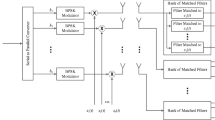Abstract
In this paper, a union bound on the bit error rate (BER) for multiple input multiple output generalized frequency division multiplexing (MIMO-GFDM) systems is derived based on exact pairwise error probabilities. The moment-generating function is used to calculate the exact pairwise error probability under the assumption that a maximum likelihood detector is used at the receiver. A realistic multipath MIMO channel environment is investigated in which the spatial correlation between antennas and the channel estimation errors are included. The Kronecker model and an additive model are used to describe the spatial correlation and channel estimation errors, respectively. The impacts of the spatial correlation and the channel estimation errors on the derived bound are investigated. The performances of MIMO-GFDM systems using different modulation techniques are also examined. Numerical calculations of the union bound and computer-based Monte-Carlo simulations of BER are carried out to verify the derived bound. Numerical results show that the derived union bound is a tight upper bound on the BER for MIMO-GFDM systems in a reasonable \(E_s/N_0\) region.






Similar content being viewed by others
Data Availability
Not applicable.
Code availability
Not applicable.
References
Fettweis, G., Krondorf, M., & Bittner, S. (2009). GFDM-generalized frequency division multiplexing. In IEEE 69th vehicular technology conference (VTC Spring 2009), Barcelona, Spain.
Michailow, N., Matthé, M., Gaspar, I. S., Caldevilla, A. N., Mendes, L. L., Festag, A., & Fettweis, G. (2014). Generalized frequency division multiplexing for 5th generation cellular networks. IEEE Transactions on Communications, 62(9), 3045–3061.
Liang, Y.-C., Chen, K.-C., Li, G. Y., & Mahonen, P. (2011). Cognitive radio networking and communications: An overview. IEEE Transactions on Vehicular Technology, 60(7), 3386–3407.
Wunder, G., Jung, P., Kasparick, M., Wild, T., Schaich, F., Chen, Y., et al. (2014). 5GNOW: Non-orthogonal, asynchronous waveforms for future mobile applications. IEEE Communications Magazine, 52(2), 97–105.
Fettweis, G. P. (2014). The tactile internet: Applications and challenges. IEEE Vehicular Technology Magazine, 9(1), 64–70.
Foschini, G. J., & Gans, M. J. (1998). On limits of wireless communications in a fading environment when using multiple antennas. Wireless Personal Communications, 6, 311–335.
Matthé, M., Zhang, D., & Fettweis, G. (2018). Low-complexity iterative MMSE-PIC detection for MIMO-GFDM. IEEE Transactions on Communications, 66(4), 1467–1480.
Matthé, M., Gaspar, I., Zhang, D., & Fettweis, G. (2015). Near-ML detection for MIMO-GFDM. In IEEE 82nd vehicular technology conference (VTC2015-Fall), Boston, MA, USA.
Tabatabaee, S. M. J. A., Towliat, M., & Rajabzadeh, M. (2021). Novel transceiver beamforming schemes for a MIMO-GFDM system. Physical Communication, 47, 101376.
Khan, M. Q., & Danish, N. M. (2021). Spatial transmit diversity for GFDM via low complexity transceiver design. In 2021 IEEE 93rd vehicular technology conference (VTC2021-Spring) (pp. 1–5).
Rakhimov, D., Deram, S. P., Sokal, B., Naskovska, K., Almeida, A. D., & Haardt, M. (2020). Iterative tensor receiver for MIMO-GFDM systems. In 2020 IEEE 11th sensor array and multichannel signal processing workshop (SAM) (pp. 1–5).
Kiessling, M., Speidel, J., Geng, N., & Reinhardt, M. (2003). Performance analysis of MIMO maximum likelihood receivers with channel correlation, colored Gaussian noise, and linear prefiltering. In IEEE international conference on communications (ICC’03), Anchorage, AK, USA (pp. 3026–3030).
Towliat, M., Tabatabaee, S. M. J. A., & Rajabzadeh, M. (2019). A simple ML detection for coded generalized frequency division multiplexing in MIMO channels. IEEE Transactions on Signal Processing, 67(3), 798–807.
Taricco, G., & Biglieri, E. (2002). Exact pairwise error probability of space-time codes. IEEE Transactions on Information Theory, 48(2), 510–513.
Lamahewa, T. A., Simon, M. K., Kennedy, R. A., & Abhayapala, T. D. (2005). Performance analysis of space-time codes in realistic propagation environments: A moment generating function-based approach. Journal of Communications and Networks, 7(4), 450–461.
Gritsch, G., Weinrichter, H., & Rupp, M. (2004). A union bound of the bit error ratio for data transmission over correlated wireless MIMO channels. In 2004 IEEE international conference on acoustics, speech, and signal processing, Montreal, Que. Canada.
Costa, N., & Haykin, S. (2010). 3. Multiple-input, multiple-output channel models: Theory and practice. Hoboken: Wiley.
Forenza, A., Love, D. J., & Heath, R. W. (2007). Simplified spatial correlation models for clustered MIMO channels with different array configurations. IEEE Transactions on Vehicular Technology, 56(4), 1924–1934.
Gucluoglu, T., & Panayirci, E. (2008). Performance of transmit and receive antenna selection in the presence of channel estimation errors. IEEE Communications Letters, 12(5), 371–373.
Tarokh, V., Naguib, A., Seshadri, N., & Calderbank, A. R. (1999). Space-time codes for high data rate wireless communication: Performance criteria in the presence of channel estimation errors, mobility, and multiple paths. IEEE Transactions on Communications, 47(2), 199–207.
Vucetic, B., & Yuan, J. (2003). 2. Space-Time Coding. West Sussex: Wiley.
Turin, G. L. (1960). The characteristic function of Hermitian quadratic forms in complex normal variables. Biometrika, 47(1–2), 199–201.
Simon, M. K., & Alouini, M. S. (2005). Digital communication over fading channels (2nd ed.). Hoboken: Wiley.
Loyka, S. L. (2001). Channel capacity of MIMO architecture using the exponential correlation matrix. IEEE Communications Letters, 5(9), 369–371.
Acknowledgements
The authors would like to thank the China Scholarship Council and the Natural Sciences and Engineering Research Council of Canada for their funding support for the work.
Funding
Yanpeng Wang received a scholarship from the China Scholarship Council. Paul Fortier received funds from the Natural Sciences and Engineering Research Council of Canada.
Author information
Authors and Affiliations
Contributions
YW and PF jointly conceived the fundamental idea of this work. YW developed the methodology, conducted related simulations, and wrote the paper. PF provided critical guidance on the methodology and simulations and revised the paper.
Corresponding author
Ethics declarations
Conflict of interest
The authors have no relevant conflicts of interest to disclose.
Ethical approval
Not applicable.
Consent to participate
Not applicable.
Consent for publication
Not applicable.
Additional information
Publisher's Note
Springer Nature remains neutral with regard to jurisdictional claims in published maps and institutional affiliations.
Rights and permissions
About this article
Cite this article
Wang, Y., Fortier, P. Union Bound on the Bit Error Rate for MIMO-GFDM Systems. Wireless Pers Commun 123, 1825–1839 (2022). https://doi.org/10.1007/s11277-021-09215-3
Accepted:
Published:
Issue Date:
DOI: https://doi.org/10.1007/s11277-021-09215-3




